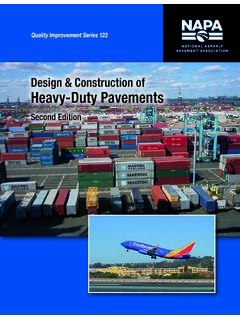Transcription of The Environmental Impact of Asphalt Plants
1 Hundreds of communities across the country coexist peacefully with Asphalt Plants . These facilities are in urban, suburban, and rural areas, and most of them are known as good neighbors who are engaged with their community and dedicated to sustainable , there is a lot of misleading and often daunting information about Asphalt Plants and Asphalt products. Therefore, it s important to understand what s fact, what s fiction, and what the differences are between different types of Asphalt with any industrial facility, it s helpful to under-stand what happens behind the gates at an Asphalt plant. This paper provides basic information about what happens at an Asphalt plant including how it impacts your neighborhood, the community, and the Regulated by the EPAA sphalt Plants , or more accurately Asphalt pavement mixing facilities, are industrial operations that mix liquid Asphalt binder (also called Asphalt cement ) with crushed rock, gravel, and sand (collectively called ag-gregates) to make pavement.
2 Asphalt binder, the glue that binds the aggregates together, is one of many distilled products obtained from the oil refining pro-cess. Similar to other refined oils, such as lubricating oils, Asphalt binder is processed to meet defined stan-dards. Some mixes also require additives, which can range from chemicals that improve mix performance to natural fibers that strength specialty mixes. The use and storage of these materials is carefully monitored and pavement mixing facilities are well-regulated by federal and state Environmental agencies, and they employ multiple emission control systems. The small amount of emissions released from these control systems are closely monitored to ensure they stay well below any permitted level set by the Environmen-tal Protection Agency (EPA) and other regulators to ensure that they pose no health or Environmental risk to nearby fact, over a decade ago, the EPA reviewed emis-sions from Asphalt Plants and determined that such facilities are not a major source of air pollution and were subsequently delisted by the Subse-quent studies by various regulatory agencies have verified that emissions from Asphalt pavement mixing facilities do not present an Environmental or public health Very Low and Getting LowerThe majority of emissions at Asphalt mixing facilities come from the combustion of fuel, such as natural gas, that are used to dry and heat the rock or aggregate and to keep the temperature of the Asphalt hot.
3 Most of the other potential emissions, such as the dust gener-The Environmental Impact of Asphalt Plantsated during the drying of aggregate, are captured by baghouse filters or similar controls and never released to the times, there may be noticeable emissions coming from an Asphalt plant s stack, but in almost all circum-stances this is just steam the loss of water vapor from the drying of aggregate at high odors from the heated materials may also emanate from an Asphalt plant. Although they may be noticeable, these odors pose no danger to ei-ther plant personnel or to the communities in which a plant operates. A noticeable odor does not indicate a health hazard; there are many instances of natural and man-made odors that are noticeable, but not harmful skunks, dairy farms, garlic, and marshlands to name but a few. Asphalt plant odors are not 2001 study2 compared emissions from an Asphalt plant to emissions from other common community and industrial sources.
4 The study found that the low annual emissions from an Asphalt plant are equivalent or well below many other common sources: Similar volatile organic compound (VOC) emis-sions from one bakery operating for about two weeks or from 13 residential fireplaces over the course of a year Less than six months worth of toluene emissions from an automotive gasoline filling stationSince 1970, the Asphalt pavement industry has docu-mented a decrease in total stack emissions of 97%, while increasing pavement production by 250%.In an effort to further reduce an Asphalt plant s envi-ronmental footprint, a number of technological advanc-es have been pursued and implemented by the as-phalt pavement industry over the past 10 years. These advances have helped reduce the amount of energy needed to make Asphalt pavements and have expand-ed the use of recycled materials in Asphalt pavements, resulting in dramatic and well-documented reductions in the carbon footprint of Asphalt fact is, Asphalt pavements have a very small car-bon footprint compared to other pavement In addition, the Department of Energy recognizes Asphalt as a top material for sequestering All Asphalt Is the SameWhen examining regulations and health information regarding Asphalt , it is important to note that the word Asphalt (or its European name bitumen) is used for multiple products that are produced and used in different ways.
5 Asphalt pavement material (sometimes called Asphalt concrete) is not the same thing as roof-ing Asphalt , and it is unrelated to coal of these materials has different components, properties, and is used at different temperatures, which results in very different potentials for emissions. The Asphalt pavement industry has spent decades advancing technology that reduces the temperature needed to produce Asphalt pavement, thereby mini-mizing and eliminating those Recyclable and InertAsphalt pavement is the most recycled material in the Not only recyclable, it can be reused over and over again in new Asphalt pavement mixes. Recycled or re-claimed Asphalt pavement (RAP) contains old Asphalt binder and aggregates that can replace virgin material requirements. The old Asphalt binder is reactivated, replacing part of the binder required in a new mix, just as the old aggregate becomes part of the aggregate content of the new pavement.
6 About 80 million tons of Asphalt pavement is reclaimed each year, and over 99% of that total is reused or is also inert. No materials are leached from the pavement itself (because it is waterproof). In fact, a number of drinking water reservoirs and fish hatcher-ies are lined with Although vehicle emissions like grease and oil may be deposited on roadways over time, emissions and leachate from RAP stockpiles have been found to be practically nonexistent. The EPA recognizes that RAP piles are unlikely to cause fugi-tive dust problems6 and can actually be used to reduce dust from unpaved roads. Numerous studies have documented that leachate or runoff from RAP stor-age is not a problem,5,7 and RAP is commonly used as clean fill material in highway addition to reclaimed Asphalt pavements, materi-als from other industries are routinely recycled into Asphalt pavements, including rubber from used tires, glass, Asphalt roofing shingles, and blast furnace slag.
7 Recycling of Asphalt pavement and Asphalt roofing shingles conserves more than 21 million barrels of liq-uid Asphalt binder Places and Controlled TrafficAlthough Asphalt Plants don t take up a large amount of real estate, they do contain a lot of equipment and are busy places to work. From the street, visible equipment may include large silos used to store the finished pavement material, big pieces of environmen-tal-control equipment to filter out stack emissions, and many stockpiles of raw materials, including sand, rocks, reclaimed Asphalt pavement, and other recy-cled Plants also contain tanks that store both fuel and liquid Asphalt . The EPA and other environ-mental agencies closely regulate these tanks to ensure that they don t rupture, and there are adequate pro-tection systems and safeguards in place to prevent any discharge in the unlikely event of a pieces of large equipment include the aggre-gate dryer drum, which is used to warm and remove moisture from the aggregate before the materials are all mixed together in a large mill.
8 The final finished pavement material is then stored in on-site silos for short periods of time before it is loaded into trucks to be taken out to a job traffic to and from a plant can be heavy, par-ticularly during the summer months when road repair and construction are greatest. To ensure that the Asphalt mix reaches the paving site at the proper tem-perature to ensure quality, Plants and paving compa-nies aim to manage truck traffic carefully to minimize delays at the plant or the paving site. Proximity to roadway work sites also plays a role in deciding where a new or temporary plant should be Plants Benefit the CommunityAsphalt Plants are good neighbors, who are active in their community. They offer opportunities for local em-ployment, and often contribute to community events with volunteers and financial donations. Many Asphalt Plants are family-owned and -operated and have been an important part of their community for to Our Nation s InfrastructureAsphalt pavements have been produced since the late 1800s in fact, naturally occurring Asphalt has been used for thousands of years as a waterproofing agent.
9 Asphalt Plants are an important link in the nation s transportation , more than 94% of the nation s 2 million miles of paved streets and highways are surfaced with Asphalt . That s because state and federal highway departments have long known that Asphalt pavements are smooth, cost-effective to construct and maintain, exceptionally durable, environmentally friendly, and 100% addition, Asphalt pavements can provide solutions for multiple forms of transportation, including walking trails, cycle tracks, bus rapid transit lanes, and airport runways. And specialty pavement mixes, such as po-rous Asphalt , are an important option for stormwater EPA (2002). National Emission Standards for Hazardous Air Pollutants: Revision of Source Category List Under Section 112 of the Clean Air Act. Federal Register, Vol. 67, No. 29, pp. 6521 6536. Connolly, . (2001). Clearing the Air.
10 Hot Mix Asphalt Technology, Vol. 6, No. 4, pp. 21 22. APA (2010). Carbon Footprint: How Does Asphalt Stack Up?, Asphalt Pavement Alliance, Lanham, Maryland. EIA (2009). Emissions of Greenhouse Gases in the United States 2008. Report DOE/EIA-0573(2008). Energy Information Administra-tion, Department of Energy. (2008).pdf5 APA (2011). Cleaner Water With Asphalt . Asphalt Pavement Alliance, Lanham, Maryland. Eastern Research Group (1996). Preferred and Alternative Methods for Estimating Air Emissions From Hot-Mix Asphalt Plants , Final Report, Vol. II, Ch. 3. Environmental Protection Agency, Washington, Townsend, , and A. Brantley (1998). Leaching Characteristics of Asphalt Road Waste. Florida Center for Solid and Hazardous Waste Management, University of Florida, Gainesville, Florida. Environmental Impact of Asphalt Plants SR 206 2014-05 Asphalt Plants Know The FactsThe National Asphalt Pavement Association (NAPA), founded in 1955, represents more than 1,100 Asphalt producers, paving contractors, and affiliated businesses that build the network of roads so critical to the American economy.











